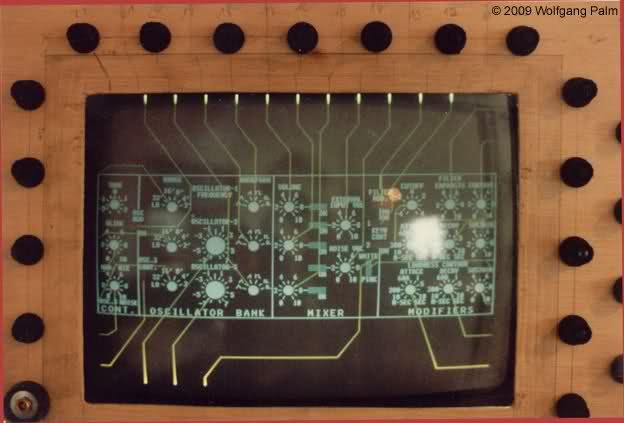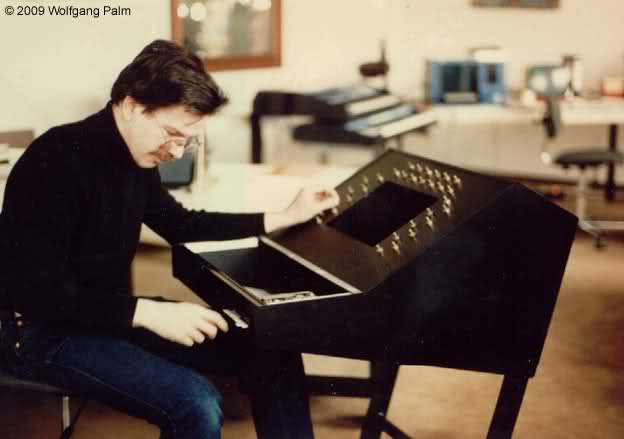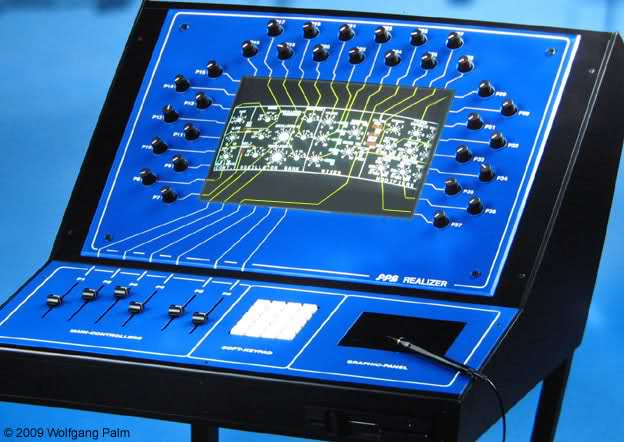The PPG Story
For some time I’d had the vision of simulating various audio building blocks like synthis, effects, mixing and recording on a computer and operate these comfortably from a monitor. At the same time technological advancements had been made and now signal processors existed (DSP’s)
These processors are specially designed for high performance processing of digital signals. The idea was to edit all the digital audio signals using multiple DSP’s and controlled by the 68000 MPU’s which had been in use for some time. Basically this is exactly what has been realised approximately 10 years later with Steinberg’s VST technology.
One must again remember that no powerful PC’s existed at the time. The most innovative computer in those days was the Apple II. However I had not anticipated and underestimated the rapid development of PC’s.
In any case, it was now full steam ahead with the hardware and software work - whereby HDU and Realizer used the same technology. They differ primarily in the number of DSPs (the HDU used 2, Realizer used up to 8). The hard disk recording, analog converter and control processor were identical.Most of the development efforts went into the "layout" of the boards (i.e. routing of the conductor paths on the circuit boards). Previously we had always done this by hand. That went well on the analog circuit boards and the 8 bit processors of the Wave, but for the multi-processor systems and 16-bit buses, we intended using software for the first time. For this purpose we leased a larger computer on which we ran the software. However the refresh rate of screen layout was extremely slow which made it difficult to work with.
The Realizer software should on each page show the main synthesizer, mixing and recording functions. On the Synthis page we thought of an analog synth in the form of a Minimoog, an FM Page (which had a modulation matrix, where different modulation paths were represented), and a sampling / wavetable model.
I also incorporated a real-time loop algorithm which was able to play pieces from the hard disk. When a MIDI-Key was received, the recording jumped to a specific position. I had recorded "Hold On" by Yes, and every time "sunshine ..." played, I pressed a key on the connected PRK in time with the rhythm. It was really impressive.
The Realizer was first unveiled at the ’86 fair, but only to a small circle of dealers and some musicians. In the early days we didn’t want to feed all sorts of people from our competitors - who always run around at the fairs – with too much information! I think at that time only the Moog and FM page worked and we could retrieve the recording of the YES piece from the hard disk.
The dealers and the press were of course completely surprised and thrilled. I still remember an article in an English music magazine, in which the author wrote: "Personally, I'd willingly swap my house, to get hold of a Realizer ...". However, when we came to negotiate for some firm pre-orders with the wholesalers, it became difficult!
The HDU was also unveiled. It was just around the time when the "Synclavier" arrived amongst the hard disk recording furore. Naturally we wanted to be a part of that scene. Michael Wehr had programmed a piece on the Waveterm B, with guitar and vocal tracks recorded on the HDU, which were all synchronized to start together. One time, Tom Oberheim appeared at the sound booth and we gave him a complete demonstrate of everything. Everyone was extremely impressed.
After the fair, the negotiations with dealers continued, and especially in the UK it looked as if the distributors who also had the “Synclavier” wanted to sell the PPG HDU. They were, however, very careful about quantities because they already knew how difficult it was to make such complicated technology "ready for production". The slogan then was: "It will fly when it flies!" In the end we awarded the distribution to "syco systems" who had already taken over this role in the early days of ’83
Video showing Tom Oberheim, Michael Wehr and Wolfgang Palm in the PPG soundbooth, and Volker Barber demonstrating the System including the HDU.
Ich hatte schon seit einiger Zeit die Vision, verschiedene Studio-Bausteine wie Synths, Effekte, Mixing und Recording auf einem Rechner zu simulieren und das ganze komfortabel auf einem Monitor zu bedienen. Gleichzeitig hatte wieder ein Technologiesprung stattgefunden: es gab nun Signalprozessoren (DSP's). Das sind Prozessoren, die speziell für hohe Rechenleistung von digitalen Signalen konzipiert sind. Die Idee war nun, alle digitalen Audiosignale mit mehreren DSPs zu bearbeiten und die Steuerung mit den von uns schon länger genuzten 68000 MPUs zu machen. Im Grunde ist es genau das, was ca. 10 Jahre später mit der VST-Technologie von Steinberg tatsächlich realisiert wurde.
Man muss sich wieder vor Augen halten, dass es damals noch keine leistungsstarken PCs gab. Der innovativste Computer war damals der Apple II. Ich habe allerdings die rasante Entwicklung der PCs nicht vorausgesehen bzw. unterschätzt.
Jedenfalls wurde nun mit Volldampf an der Hardware und Software gearbeitet - wobei HDU und Realizer dieselbe Technik verwendeten. Sie unterschieden sich vor allem durch die Anzahl der DSPs (bei der HDU 2, beim Realizer bis zu 8). Das Harddisk-Recording, die Analog- Converter und der Steuerprozessor waren identisch. Der meiste Entwicklungsaufwand lag damals im "layouten" der Platinen (also das Festlegen des Verlaufes der Leiterbahnen auf den Platinen). Früher hatten wir das immer von Hand gemacht. Das ging auch bei den Analogplatinen und den 8-bit-Prozessoren des Wave noch ganz gut. Aber mit den Multiprozessor-Systemen und 16bit-Bussen wollten wir das erste Mal eine Software dafür einsetzen. Dazu hatten wir einen grösseren Computer geleased, auf dem diese Layout-Software lief. Allerdings war der Bildaufbau dermaßen langsam, dass es sehr schwierig war, damit zu arbeiten.
Die Software des Realizers sollte auf jeweils einer Page die wichtigsten Synthesizer sowie das Mixing und Recording abbilden. An Synthis war ein Analog-Synth in Form eines Minimoog gedacht, eine FM-Page (wobei über eine Matrix die unterschiedlichen Modulationswege dargestellt waren), sowie ein Sampling/Wavetable-Modell.
Ich hatte auch einen Realtime-Loop-Algorithmus eingebaut, mit dem man ein Stück von der Harddisk spielen konnte. Wenn ein MIDI-Key empfangen wurde, sprang das Recording an eine bestimmte Position zurück. Ich hatte dazu "Hold On" von Yes aufgenommen, und immer wenn dieses "sunshine..." kam, drückte ich bei den Vorführungen, synchron zum Rhytmus die Taste auf dem angeschlossenen PRK. Es war sehr beeindruckend.
Auf der Messe '86 wurde der Realizer das erstemal vorgestellt, allerdings nur einem kleinen Kreis von Händlern und einigen Musikern. Wir wollten nicht in diesem frühen Stadium alle möglichen Leute von der Konkurrenz - die auf den Messen immer umherlaufen - mit Informationen versorgen! Ich glaube, zu dem Zeitpunkt liefen nur der Moog und die FM-Page, und wir konnten das Recording mit dem Yes-Stück von der Harddisk abrufen. Die Händler und die Presse waren natürlich total überrascht und begeistert. Ich erinnere noch einen Artikel in einer englischen Musikzeitung, in dem der Author schrieb: "Personally, I'd willingly swap my house, to get hold of a Realizer...". Wenn es jedoch darum ging, mit den Grosshändlern ein paar konkrete Vorbestellungen zu verhandeln, wurde es schwierig!
Die HDU wurde ebenfalls vorgeführt. Es war gerade die Zeit, als das "Synclavier" mit dem Harddiskrecording Furore machte. Da wollten wir natürlich mit von der Partie sein. Michael Wehr hatte ein Stück auf dem Waveterm B programmiert, und auf der HDU waren Gitarren- und Vocal-Tracks eingespielt, die synchron dazu eingestartet wurden. Einmal erschien auch Tom Oberheim in der Schallkabine und liess sich das Ganze vorführen. Alle waren sehr beeindruckt.
Nach der Messe gingen die Verhandlungen mit Händlern weiter, und speziell in UK sah es so aus, dass der Vertrieb, der auch das "Synclavier" hatte, die PPG-HDU vertreiben wollte. Sie waren allerdings sehr vorsichtig mit Stückzahlen, weil sie schon wussten, wie schwer es ist, eine so komplizierte Technik "serienreif" zu machen. Der Spruch war dann: "it will fly, when it flys!". Wir haben dann aber letzten Endes den Vertrieb an "syco systems" vergeben, die auch schon in der frühen Tagen '83 diese Aufgabe übernommen hatten.
First mockup of the Realizer panel
 Detlev Paschen checking the operability
Detlev Paschen checking the operability
 First prototype
First prototype
